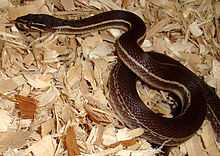Boaedon lineatus
| Striped House Snake | |
|---|---|
 | |
| Scientific classification | |
| Superkingdom: | Eukaryota |
| Kingdom: | Animalia |
| Subkingdom: | Eumetazoa |
| Phylum: | Chordata |
| Subphylum: | Vertebrata |
| Infraphylum: | Gnathostomata |
| Superclass: | Tetrapoda |
| Class: | Reptilia |
| Subclass: | Diapsida |
| Infraclass: | Lepidosauromorpha |
| Superorder: | Lepidosauria |
| Order: | Squamata |
| Suborder: | Serpentes |
| Infraorder: | Caenophidia |
| Superfamily: | Elapoidea |
| Family: | Lamprophiidae |
| Subfamily: | Boodontinae |
| Genus: | Boaedon |
| Species: | B. lineatus |
| Binomial name | |
| Boaedon lineatus (Duméril & Bibron, 1854) | |
The Striped House Snake (Boaedon lineatus) is a species of colubrid from Africa. This species has a wide range stretching from Tanzania through Central Africa as far as Uganda. They are kept as pets with increasing regularity, they are often captured and exported for the pet trade. There are at least two subspecies (below). Until November of 2010, this species was grouped in the genus: Lamprophis but a paper was published by Kelly et al. reclassifying this species to the Boaedon genus. [1]
Appearance
This species is highly variable in appearance, their colour varying from deep black through light reddish brown. Their eyes are large & 'bug-like' with vertical elliptical pupils. Stripes stretch from the rostral scale above the mouth through the eye to the rear of the head where they terminate. On the sides, thick, bold white/cream stripes stretch laterally along the length of the body, these occasionally terminate after around two thirds of the body & may be broken or very pale. Striped House Snakes are highly sexually dimorphic, females growing far larger than males, reaching lengths of around 100 centimetres (39 in) males generally smaller rarely exceeding 60 centimetres (24 in). As with all members in the genus Boaedon these snakes are highly iridescent, having an oil-on-water sheen in certain lights.
Behaviour and diet
In the wild, this species is known to occur around human habitation, opportunistically feeding on the rodents that gather there around human waste. They are known to feed on chicks & small lizards also. They are known to breed year-round and, unlike in captivity, breed once per year. Hatchlings are usually around 15 centimetres (5.9 in) in length. These are nocturnal in nature and are known to occur at 1000 feet above sea level.

In captivity
This species is increasingly more common in captivity with more individuals beginning to keep and breed them. They are often imported from Tanzania as Wild Caught or Captive Farmed individuals. No known genetically inheritable mutations are currently available. This species fares well in captivity, with some TLC they feed well on defrosted rodents & breed, laying 3–6 clutches of around 8–15 eggs per year. Care is basic & in time, as they become more readily available, this species should grow in popularity.
External links
| Wikimedia Commons has media related to Category:Boaedon. |
References
- ↑ Kelly, C.M.R., et al. Molecular systematics of the African snake family Lamprophiidae, Fitzinger, 1843 (Serpentes: Elapoidea), with particular focus on the genera Lamprophis, Fitzinger 1843 and Mehelya, Csiki 1903. Mol. Phylogenet. Evol. (2010), doi:10.1016/j.ympev.2010.11.010